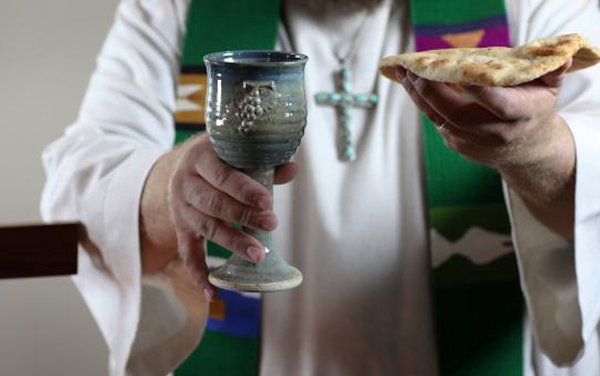Meet four older United Methodist pastors with energy and fire and no plans to ‘hang it up.’
SAM HODGES
United Methodist News Service
At 67, the Rev. David Clewell is still a pastor, and he’s not sure when he’ll hang it up.
“We’re getting ready to start a building project,” said Clewell, who leads Quail Springs United Methodist Church in Oklahoma City, Oklahoma. “I’m wanting to see that through.”
The Rev. David Comperry is 69, and, like Clewell, a grandfather. But he’s still going strong as pastor of Emmanuel United Methodist in Memphis.
“I’ve got good health, I enjoy what I’m doing, and I still feel I’ve got some things to contribute,” said Comperry, in his 44th year of ministry.
Clewell and Comperry are part of a move toward later retirement by United Methodist clergy in the United States, identified in a new Clergy Age Trends Report by the Lewis Center for Church Leadership.
In 2005, the average age of retiring United Methodist elders was 64, but by last year that had climbed to 66, the Lewis Center found in analyzing data provided by Wespath Benefits and Investments, formerly the United Methodist Board of Pension and Health Benefits.
The average retirement age for deacons in 2015 was 67. For full-time licensed local pastors, the average retirement age was 68, and for part-time local pastors it was 69.
Incentives for sticking around
The Rev. Lovett Weems Jr., director of the Lewis Center, said there was a lot of talk during the 2008 recession that United Methodist pastors were postponing retirement because their nest eggs had been reduced.
The Lewis Center — part of United Methodist Wesley Theological Seminary in Washington, D.C. — did not research the reasons. Nor has Wespath done a formal study, said Andrew Hendren, general counsel .However, he said no real spike in retirement age emerged in the data. Instead, there has been a longer, gradual trend.
But Hendren noted that the 2008 General Conference pushed back mandatory retirement age for clergy from 70 to 72. He said another factor might be that most people now work to 66, to get full Social Security benefits.
He added that some conferences, to deal with rising costs, have cut back or eliminated health care coverage for pre-Medicare retirees.
“Such changes may have had the effect of encouraging more clergy to continue working until they are at least 65 and thereby Medicare-eligible,” Hendren said.
Finding fulfillment
For the Rev. Lynn Schreck, finances aren’t the reason she is, at 65, still leading two small southwest Wisconsin churches. It’s that she finds deep fulfillment doing so.
What Schreck does worry about is who will take her place, given that finding clergy for smaller, rural churches, can be a challenge in Wisconsin.“The way I look at it is: It’s not work; it’s just who I am,” said Schreck, pastor of Salem United Methodist Church in Eastman and St. Paul’s United Methodist Church in Wauzeka. “And my health is still good.”
Church law allows pastors who are officially retired to continue to be appointed, though they aren’t guaranteed a pension contribution and housing allowance.
Such pastors aren’t reflected in the Lewis Center study, but they are important to keeping churches going in some conferences, Weems said.
The Rev. Robert Marble is an example. He’s 79, and has no plans to step down as pastor of Mabelvale United Methodist Church, in Mabelvale, Arkansas.
Some point to the many second-career United Methodist pastors as one reason for later retirements, and Marble said his late start — after a business career — is one reason he’s eager to keep going.“I intend to stay on until the Lord calls me home or the bishop finally says, ‘We’ve had enough of you,’” Marble said.
“The Lord called me at 13, but I didn’t go until I was 53,” Marble said. “I’ve still got a lot of energy and fire.”
He added that the break Mabelvale United Methodist gets in not having to make his pension and housing allowance payments means more money for other staff and missions. He’s proud of the church, including its community outreach.
“Our motto is: ‘We love you and there’s nothing you can do about it,’” Marble said.
The shrinking middle
The Lewis Center’s look at clergy retirement age comes in its annual Clergy Age Trends Report, which is best known for its reporting on young clergy numbers.
This year’s study again shows a modest climb in that category. The denomination has just over 1,000 elders under age 35, constituting 6.8 percent of active elders.
In 2005, the denomination had 850 young elders, or about 4.7 percent.
Nearly all the growth in young elders has been among women.
The new study also confirms the shrinking pool of middle-age elders. In 2000, they represented 65 percent of active elders, and now are just 37 percent.
Meanwhile, the study found a continuing record high 56 percent of active elders are between ages 55 and 72.
“You need a healthy mix of (clergy) ages,” Weems said, adding that The United Methodist Church is “significantly skewed” toward older elders.
The denomination has been gradually shrinking in U.S. membership and worship attendance, and the overall elder ranks have shrunk dramatically. This year’s study showed declines in both elders and local pastors, though the former declined more.
Local pastor numbers have generally been on the rise, and the denomination now has two elders for each local pastor, while in 1990 the ratio was five to one.
Last Updated on January 30, 2024

